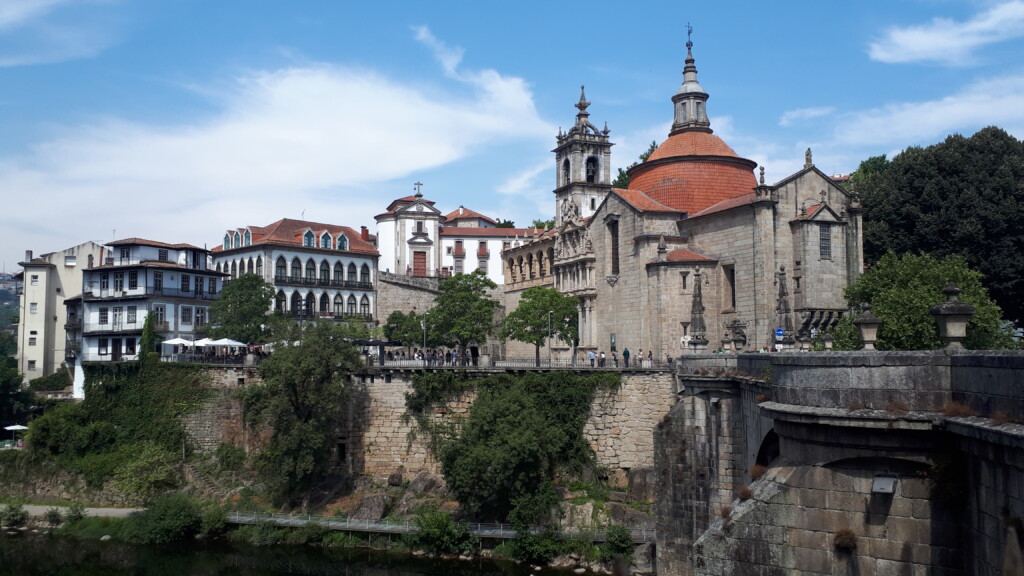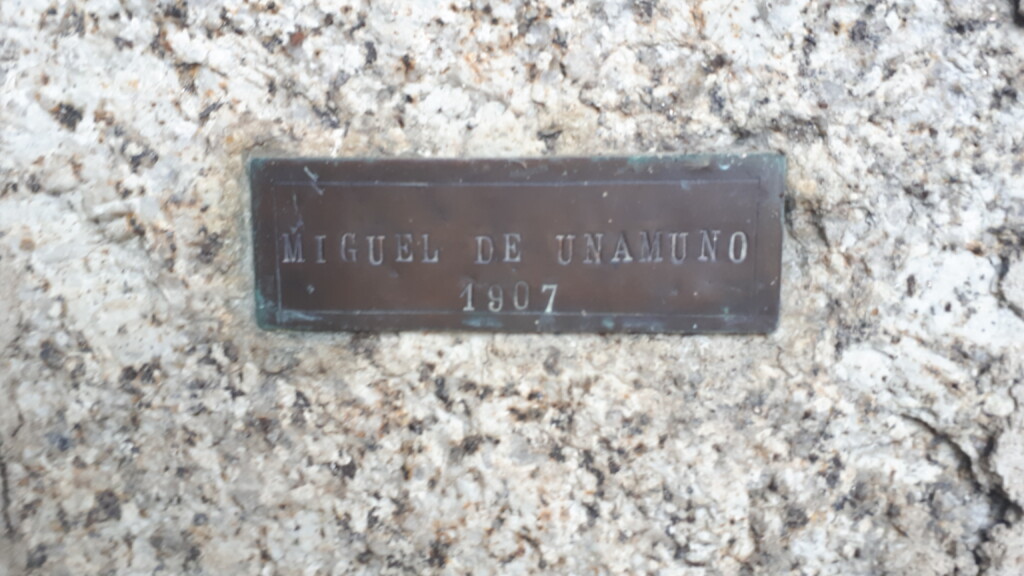* Please, scroll down for the English version of the text
Czy coś Wam mówi nazwisko Dulce Pontes? To dobrze. A Fernando Pessoa? Tym lepiej. Do jednego z wierszy z Mensagem artystka dopisała muzykę i wyszedł przepiękny utwór O infante na płycie Caminhos. „Deus quer, o homem sonha, a obra nasce…” A o czym mówi poeta? Ustami księcia Henryka Żeglarza mówi o tym, iż marzy, by Portugalia stała się tym, czym powinna być, by się spełniła, odnalazła swoją tożsamość… W historii każdego narodu, ba, w życiu każdego człowieka przychodzi taki moment, kiedy trzeba się nad sobą zastanowić, odnaleźć odpowiedź na pytanie, skąd przychodzimy, dokąd zmierzamy, co nam w duszy gra. Fernando Pessoa, dziś najbardziej znany portugalski poeta, podjął tę myśl od swoich poprzedników, twórców z przełomu wieków XIX i XX, wśród których jeden w sposób szczególny zastanawiał się, co to znaczy być Portugalczykiem. Między łykiem wina w domu a kawy w kafejce São Gonçalo, opodal katedry w Amarante.
Amarante, miasto w północnej Portugalii, nad rzeką Tâmega. Z rzeki w stronę nieba strzelają wysokie filary kamiennego mostu, których bieg podejmuje kamienna katedra świętego Gonsalwego. Gdy już zwiedzimy katedrę, zrobimy sobie zdjęcie na rynku, popatrzymy na rzekę, czy niska dziś czy wysoka, przychodzi myśl, by napić się kawy i zjeść coś słodkiego. A jeśli chodzi o słodycze, to w Portugalii jest w czym wybierać. Może więc tu zaraz obok katedry, Café São Gonçalo? Zaraz, zaraz, gdzie moja maseczka… A beret? A po co mi beret? No tak, mnie do niczego nie jest potrzebny. Lecz gdy do tej kawiarni wchodził poeta w berecie, obsługa wiedziała, żeby mu nie przeszkadzać, bo właśnie pod tym beretem wykluwał się nowy wiersz…
Tym poetą był Teixeira de Pascoaes (wł. Joaquim Pereira Teixeira de Vasconcelos), znany w historii literatury jako prekursor tzw. saudosismo. „Teixeira de Pascoais, autor kilku tomików wierszy napisanych podczas studiów prawniczych w Coimbrze, takich jak Sempre („Zawsze”, 1897), A minha alma („Moja dusza”, 1898) i Terra proibida („Ziemia zakazana”, 1899), rozpoczął poszukiwanie tychże wartości na gruncie refleksji filozoficznej, snując rozważania nad pojęciem saudade rozumianym jako stan ducha i specyficzna predyspozycja mentalna Portugalczyków. Ta panteistyczna filozofia, rozważająca w kategoriach saudade nie tylko naród i jego sprawy, ale i cały wszechświat, znalazła poetycki wyraz w zbiorach poezji Teixeiry de Pasocaisa Vida etérea („Ulotne życie, 1907), As sombras („Cienie”, 1907), A senhora da noite („Pani nocy”, 1909), Maranos („Żydzi”, 1911), a przede wszystkim w Regresso ao paraíso („Powrót do raju”, 1912), gdzie znajdujemy najpełniej wyrażoną ideę, iż saudade odgrywa kluczową rolę w dziejach ludzkości jako siła kierująca swoistą ewolucją ducha, której ostatecznym celem jest odbudowa raju, a także przeistoczenie Portugalczyka w Człowieka Powszechnego (Homem Universal)” [Ewa Łukaszyk, Mgławica Pessoa, s. 191. BUW WD PQ 9050.L852019].
Po kilku latach pracy jako sędzia w Amarante Teixeira de Pascoais rzucił tę robotę i wrócił do rodzinnego majątku w São João de Gatão (dziś jest to jedno z przedmieść Amarante) i zajął się gospodarowaniem i nadzorowaniem rodzinnych dóbr. A w przerwie pisał i podejmował gości: pisarzy, malarzy, filozofów…
Dom Teixeiry de Pascoaisa w dalszym ciągu stoi dla gości otworem, z tą różnicą, że odwiedza się go raczej jako turysta. Ze wszech miar jednak warto tam pojechać! Teraz w tekście jest to miejsce, kiedy brakuje mi słów. Na szczęście mam w głowie linijki złożone przez Wieszcza… Rezydencja rodziny Vasconcelos, bo tak chyba trzeba nazwać ten typ obiektu, składa się z dworu, ogrodu i przylegających doń winnic. Dwór mieszkalny jednopiętrowy, w kształcie litery U, w stylu manierystycznym, neoklasycystycznym, wita przybyszów przepiękną klatką schodową wyłożoną do połowy azulejos.
Na dziedziniec przechodzi się przez dwie bramy z miniaturowymi ogródkami, zapowiadającymi piękno głównego ogrodu, położonego na tyłach domu. Część parteru, z przepięknym salonem (w miejscu po dawnych piwnicach) oraz kilka pokoi obok przeznaczono dla gości. Z salonu, lub z pokojów, można wyjść do ogrodu i posiedzieć w ciszy, i poczytać, i pomyśleć. Wspaniałej ciszy nie zakłóca nawet szmer wody z pobliskiej fontanny. Wręcz przeciwnie: tym większemu sprzyja zamyśleniu nad naturą świata, jego przemijaniem i wiecznością.
Dokładnie tak wyglądał nasz pobyt w domu poety. Przyjazd w poniedziałek wieczorem. Wtorek rano – wizyta w pobliskim Amarante, a po atrakcjach turystycznych miasta nad rzeką Tâmega leniwe popołudnie w ogrodzie. Z książką w ręku. W tle ciurka fontanna z dwiema splecionymi kamiennymi delfinami, których pilnują święty Antoni ze świętym Janem Chrzcicielem, a przed oczyma rozciąga się malowniczy horyzont, z zielenią winnic, czerwienią dachów i błękitem nieba. Jak niewiele potrzeba do szczęścia!

Jedna z fontann w ogrodzie 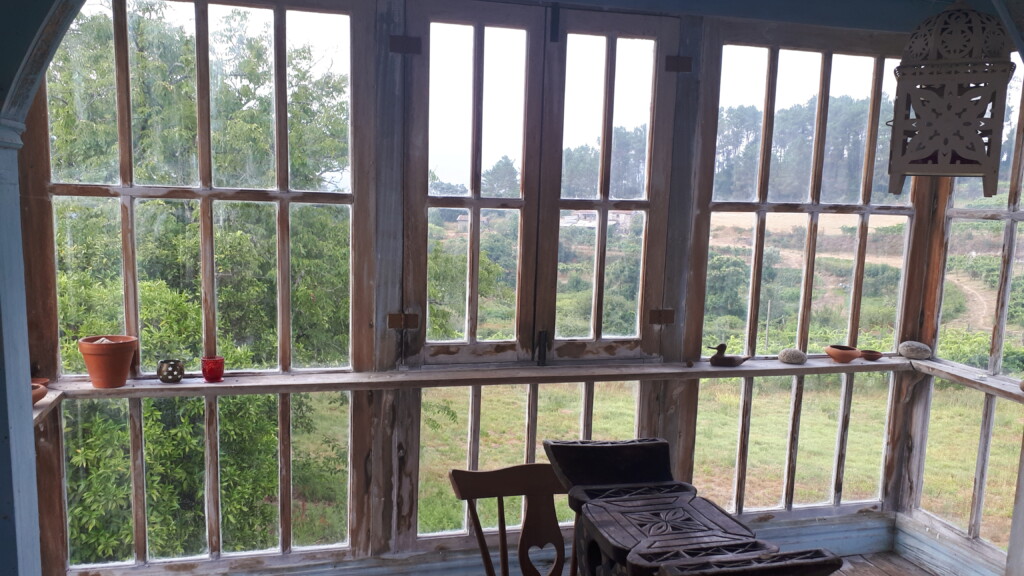
Pawilon ogrodowy, w którym pracował poeta 
Pawilon ogrodowy, w którym pracował poeta 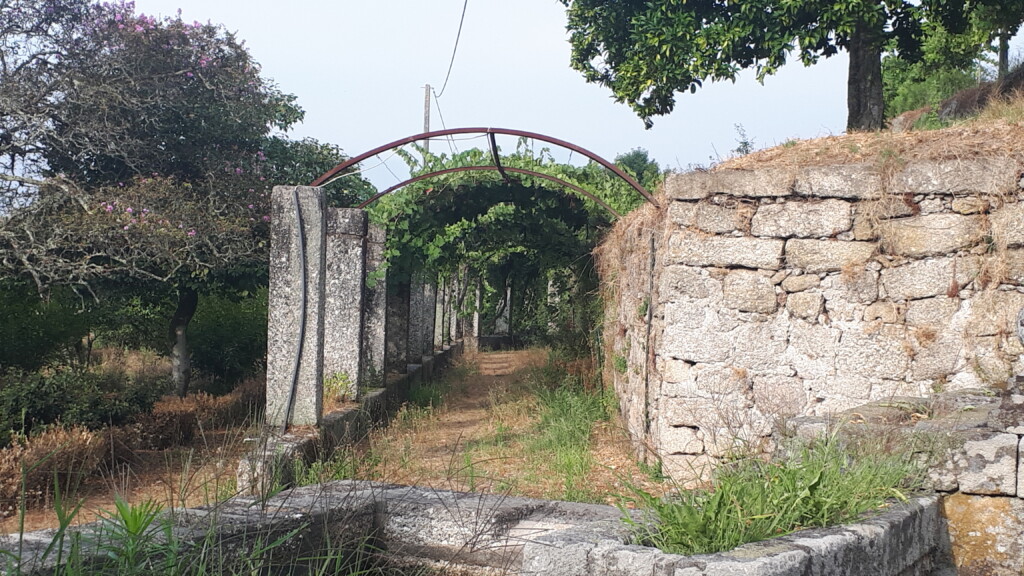
Pergole z winoroślą 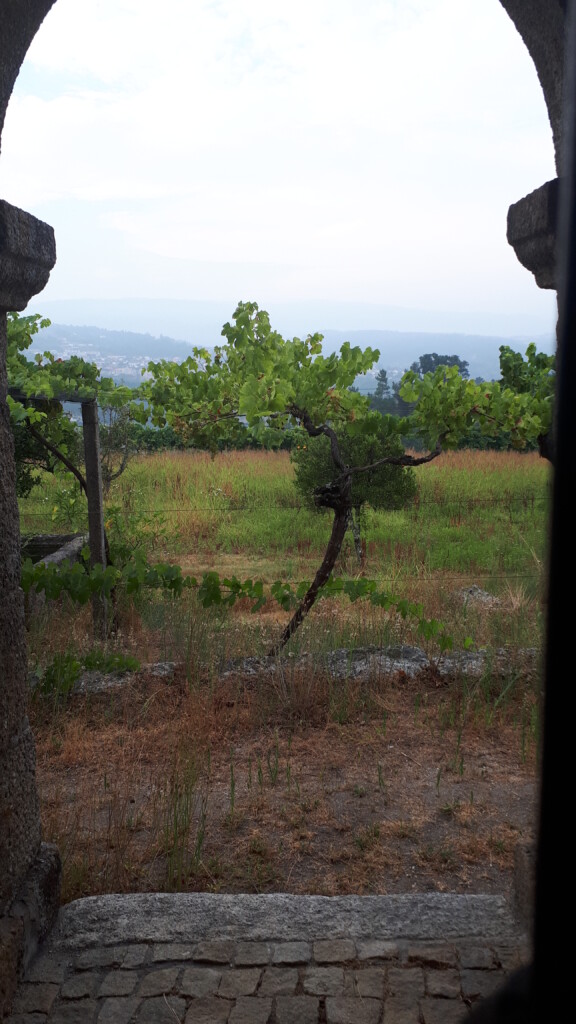
Widok na ogród 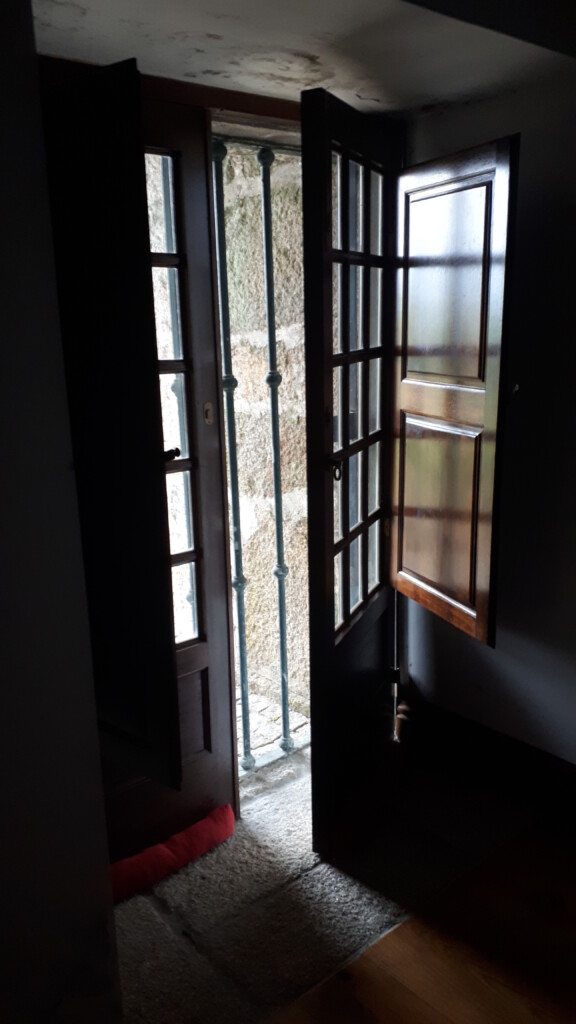
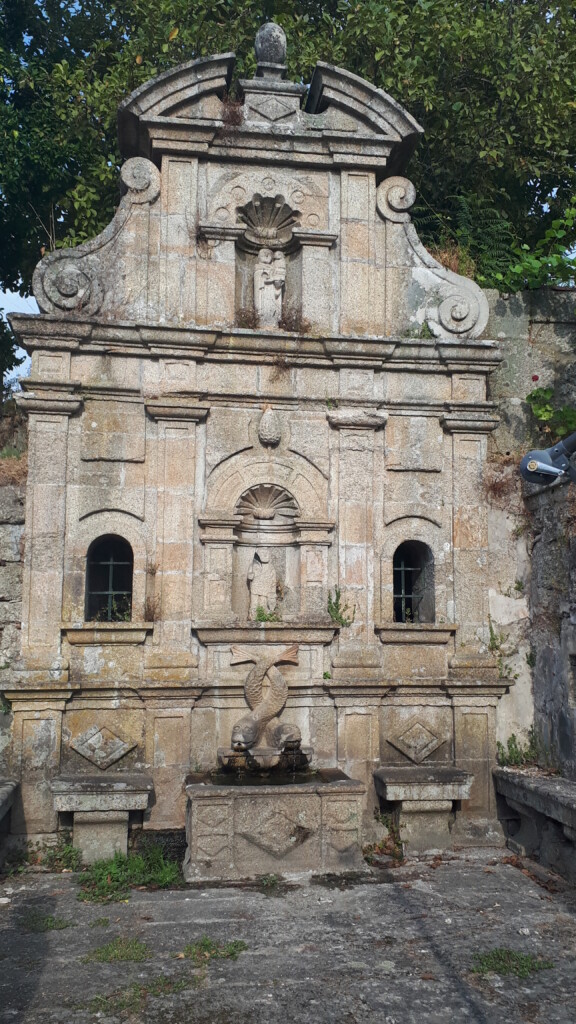
Fontanna z delfinami 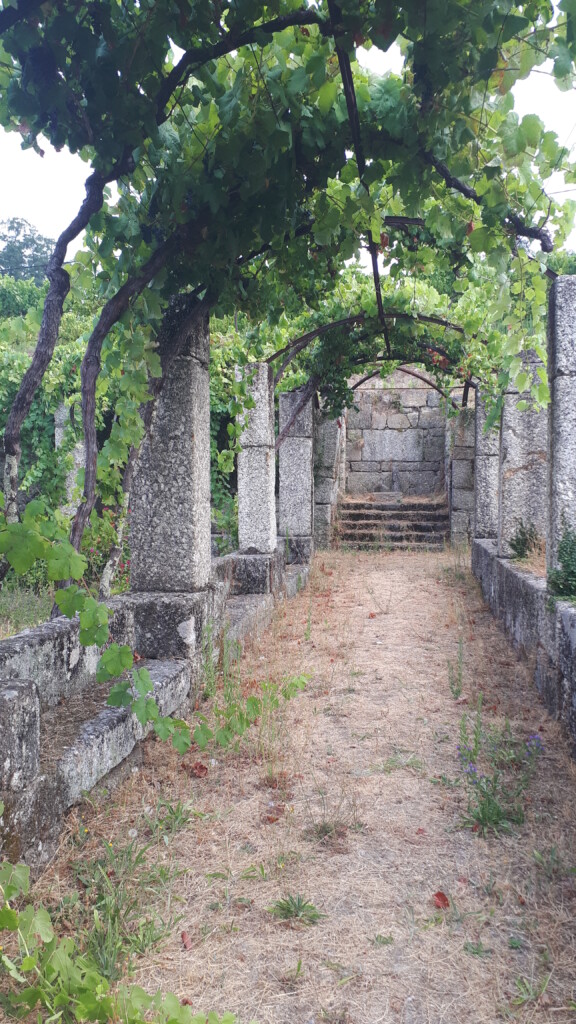

Jakby kolorowego szczęścia przed oczami było mało, spokoju wtorkowego popołudnia nie zakłócali nam inni goście, więc pani Leonor Vasconcelos, krewna poety, wnuczka jednego z jego braci, oprowadziła nas także po zabytkowej części domu, w tym po pracowni artysty i po bibliotece. Teixeira de Vasconcelos żył bardzo skromnie, w opinii bliski prowadził wręcz mnisze życie. Jego pokój, z własnoręcznie zaprojektowanymi meblami, przylega do biblioteki, do której przechodzi się przez wąski korytarzyk. Biblioteka mieści się w dwóch pokojach, gdzie wokół trzech ścian biegną półki z książkami, a w czwartej ścianie okno ze wspaniałym widokiem na już znany nam ogród. To okno wspomina Miguel de Unamuno, a wspominając widzi w nim Teixeirę de Pascoaisa, jak ten żegna się ze słońcem, z wiatrem, z niebem, by znów powitać je następnego dnia [Miguel de Unamuno, Por Tierras de Portugal y Espanha]. Bardzo to wszystko poetyckie, nieprawdaż? I z jakim zachwytem opisane! A czemużby nie? W końcu w każdym z nas, głęboko ukryta pod pokładami kurzu rozpędzonej współczesności, tkwi tęsknota za domem, za ogrodem, za dobrą opowieścią, za ciepłem rodzinnego ogniska. O, właśnie! O wilku mowa. Mimo pięknego w swej surowości pokoju i wspaniałej biblioteki z widokiem na nieskończoność, najcudowniejszym miejscem w tym domu jest… kuchnia.

Wnętrze kuchni domu Teixeiry de Pascoaisa
Do kuchni wchodzi się z poziomu pierwszego piętra po schodkach. I na samym szczycie schodów naszym oczom ukazuje się palenisko – serce ciemnoszarej kamiennej kuchni. Dziś już nieczynne, ale żeliwny kocioł wciąż nad nim wisi i czeka. W kuchni stoją też dwa kamienne stoły, na stałe złączone z podłogą. Zresztą i tak by nikomu nie przyszło do głowy, żeby je przesuwać. Na ścianach wiszą różne sprzęty kuchenne. Jest też jeszcze jedna figurka świętego Antoniego. Kuchnia do dziś jest używana, a i za czasów Pascoaisa odbywały się w niej, jak to zwykle w kuchni bywa, najlepsze imprezy. Kuchnia i przydomowa kaplica to dwie oryginalnie zachowane części tego domu z XVII wieku. Resztę trzeba było odbudować po pożarach wzniecanych przez wojska napoleońskie.
Ojciec pani Leonor, który odziedziczył dom po śmierci Teixeiry de Pascoaisa, był malarzem. Jego obrazy zdobią wiele ścian tej przepięknej rezydencji. Przyjaźnił się z innymi malarzami, z pisarzami, artystami, z czasem dom otrzymał nazwę „domu poezji”. Dom ten znalazł także swoje miejsce w trzytomowym wydawnictwie „Casas de Escritores: no Douro, no Minho, no Alentejo”… Ach, taka jeszcze we mnie tęsknota za nieodkrytym światem! I za domem z ogrodem.
Tekst: Barbara Chmielewska, Oddział Gromadzenia i Uzupełniania Zbiorów
Foto: ze zbiorów własnych publikujemy za zgodą Leonor Vasconcelos
Does the name Dulce Pontes say anything to you? That’s good. And Fernando Pessoa? Even better. To one of the poems from Mensagem the singer added music and wrote the beautiful song O infante from the album Caminhos. „Deus quer, o homem sonha, a obra nasce…” And what does the poet talk about? Through the lips of Prince Henry the Sailor, he says that he dreams of Portugal becoming what it should be, fullfiling its mission, finding its identity. In the history of every nation, and indeed in the life of every person, there comes a moment when one has to reflect on oneself, to find the answer to the question of where we come from, where we are going to, what really is in the depth of our soul. Fernando Pessoa, today the most famous Portuguese poet, has taken up this thought from his predecessors, creators of the turn of the 19th and 20th centuries, one of whom was particularly wondering what it means to be Portuguese. Between a sip of wine at home and a coffee in the café of São Gonçalo, near the cathedral in Amarante.
Amarante, a city in northern Portugal, on the Tâmega River. From the river high pillars of the stone bridge rise towards the sky, and their course is taken seamlesly by the stone cathedral of St. Gonçalo. Once we visit the cathedral, take a picture of ourselves in the market square, look at the river, whether low or high today, we get the need to have a coffee and something sweet along. And when it comes to sweets, there is really something to choose from in Portugal. So maybe here, right next to the cathedral, Café São Gonçalo? Wait, wait, where is my mask… And the beret? Why do I need a beret? Well, me, I don’t need any. But when a poet entered this cafe in a beret, the staff knew not to disturb him, because under this beret a new poem was just hatching…
This poet was Teixeira de Pascoaes (real name: Joaquim Pereira Teixeira de Vasconcelos), known in the history of literature as a precursor of the so-called saudosismo. „Teixeira de Pascoais, author of several volumes of poems written during his legal studies in Coimbra, such as Sempre („Always”, 1897), A minha alma („My Soul”, 1898) and Terra proibida („Forbidden Land”, 1899), began his search for these values on the basis of philosophical reflection, reflecting on the concept of saudade as a state of mind and a specific mental predisposition of the Portuguese. This pantheistic philosophy, considering in terms of saudade not only the nation and its affairs, but also the entire universe, found a poetic expression in the poetry collections of Teixeira de Pasocais Vida etérea („Escaping Life, 1907), As sombras („Shadows”, 1907), A senhora da noite („A Lady of the Night”, 1909), Maranos („Jews”, 1911), and above all in the Regresso ao paraíso („Return to Paradise”, 1912), where we find the most fully expressed idea that saudade plays a key role in the history of mankind as the driving force for a kind of evolution of the spirit, whose ultimate goal is to rebuild Paradise and to transform the Portuguese into a Universal Man (Homem Universal)”. [Ewa Łukaszyk, Mgławica Pessoa, p. 191, BUW WD PQ 9050.L852019].
After several years as a judge in Amarante Teixeira de Pascoais quit the job and returned to the family estate in São João de Gatão (today it is one of the suburbs of Amarante) and took up the management and supervision of the family estate. And among those houshold chores he dewoted huimself to writing, received guests, met his friends: writers, painters, philosophers…
The House of Teixeira de Pascoais is still open for guests, mostly tourists. It is worth going there by all means! Now, in the text, there comes a moment where I am lack of words. Fortunately, I have in my head the lines put together by Adam Mickiewicz (Polish equivalent of Luís Camões)… The residence of the Vasconcelos family, because that’s probably how this type of object should be called, consists of a manor house, a garden and adjacent vineyards. The manor house is a one-storey, U-shaped, mannerist, neoclassical mansion, and welcomes the visitors with a beautiful staircase covered in a hlaf with azulejos. To the courtyard you pass through two gates with miniature gardens, early heralds of the beauty of the main garden located at the back of the house. Part of the first floor, with a beautiful living room (in the place of the former cellars) and a few rooms next door are designated for guests. From the living room, or from the rooms, you can go out into the garden and sit in silence, and read and think. The wonderful silence is not disturbed even by the murmur of water from the nearby fountain. On the contrary, it is all the more conducive to thinking about the nature of the world, its fragility and eternity.
This is exactly how our stay in the poet’s house looked like. Arrival on Monday evening. Tuesday morning – visit to nearby Amarante, and after the tourist attractions of the city on the Tâmega river a lazy afternoon in the garden. With a book in the hand. In the background, there was a fountain with two intertwined stone dolphins, watched over by Saint Anthony and Saint John the Baptist, and in front of our eyes there was a picturesque horizon with green vineyards, red roofs and blue sky. How little do we need to be happy!
As if colorful happiness in front of our eyes was not enough , the peace of Tuesday afternoon was not disturbed by other guests, so Mrs. Leonor Vasconcelos, a relative of the poet, granddaughter of one of his brothers, also showed us around the historic part of the house, including the artist’s studio and the library. Teixeira de Vasconcelos lived a very modest life, in the opinion of his friends he led a life of a monk. His room, with its own designed furniture, is adjacent to the library, which is accessed through a narrow corridor. The library is located in two rooms, with three walls around with bookshelves and in the fourth wall there is a window with a wonderful view of the already known garden. This window is mentioned by Miguel de Unamuno. In his memories he sees Teixeira de Pascoais as he says goodbye to the Sun, to the wind, to the sky, to welcome them again the next day [Miguel de Unamuno, Por Tierras de Portugal y Espanha]. It is all very poetic, isn’t it? And what a delight in description! And why not? In the end, in each of us, deeply hidden under the dust of the rushing present day, lies the longing for home, for the garden, for a good story, for the warmth of the family fire. Oh, that’s it! Despite a beautiful room in its austerity and a wonderful library overlooking infinity, the most wonderful place in this house is… the kitchen.
The kitchen is situated on the second floor. And, as you enter, at the very top of the stairs a hearth appears to our eyes – the heart of the dark grey stone kitchen. Today it stays unused but the cast-iron boiler is still hanging over it and waiting in a stand-by mode. In the kitchen there are also two stone tables, permanently connected to the floor. Anyway, nobody would have thought to move them anyway. Various kitchen utensils hang on the walls. There is also another statue of St. Anthony. The kitchen is still in use today, and even during the time of Pascoais the best parties were held there, as usual in the kitchen. The kitchen and the house chapel are two originally preserved parts of this house from the 17th century. The rest had to be rebuilt after the fires set by Napoleon’s troops.
The father of Mrs. Leonor, who inherited the house after the death of Teixeira de Pascoais, was a painter. His paintings adorn many walls of this beautiful mansion. He became friends with other painters, writers and artists, and over time the house was named „house of poetry”. This house also found its place in the three-volume edition „Casas de Escritores: no Douro, no Minho, no Alentejo”… Oh, there is still so much longing for the undiscovered world in me! And for a house with a garden.
Text: Barbara Chmielewwska, Acquisition and Collection Development Department
Photo: property of the author, with the courtesy of Leonor Vasconcelos

